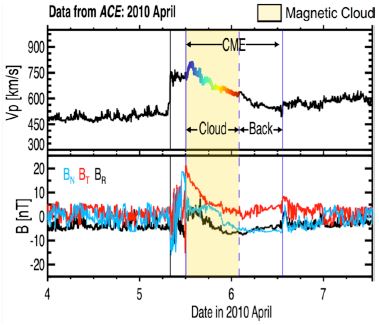Visualizing Coronal Mass Ejection Flux Ropes in 3-D
PDF version

Figure 1:
Three different projections of a 2010 April CME reveal the 3-D internal structure
inferred via STEREO and SOHO. The central dense structure exhibits right-handed chirality.

|
| Figure 2: The magnetic rotation at ACE is consistent with a glancing blow from a right-handed helix propagating from the Sun to Earth as tracked by imaging. Top: Solar wind speed. Bottom: magnetic field. |
In a recent paper ACE solar-wind measurements from SWEPAM and MAG were used to verify the first remote measurement of CME chirality (handedness) using the polarization properties of visible light. Polarized imaging of Thomson-scattered light can identify 3-D structure and chirality of solar ejecta on a global basis, complementing the more detailed measurements available in-situ at L1; but this process has proved difficult because it requires 0.01%-level relative photometry of the polarized coronagraph signal.
Chirality is an indicator of magnetic helicity - a topological quantity produced by differential rotation in the Sun and conserved in the corona. CMEs can be understood as primarily a means for the corona to eject magnetic helicity transported upward from the solar interior.
Determining CME chirality bridges the gap between magnetograph measurements of the pre-CME coronal structure, and prediction of the leading-edge Bz direction when the ejecta reach Earth. Magnetic field near the leading edge of a transverse flux rope can be directed nearly 90° from the axis of the flux rope, due to twist in the extended structure. The rotation direction depends on the flux rope's chirality (direction of twist), which is not revealed by conventional visible or EUV images of the optically thin corona.
The authors extracted the chirality of a bright (dense) helix that was visible in the CME core, determining that it is right-handed. They hypothesized that the morphology traced the underlying field, and used ACE data (from the CME's traversal of L1) to verify that connection, opening the way for future routine measurements of CME chirality using polarized light.
This study is in press at The Astrophysical Journal.
This item was contributed by Craig DeForest at Southwest Research Institute in Boulder, CO. Address questions and comments to
ACE News Archives
Subscribe to ACE News
ACE Homepage
Last modified 30 Nov 2017.